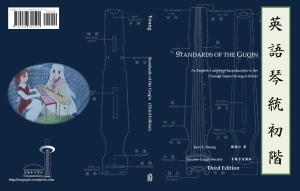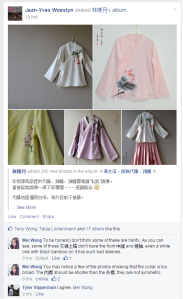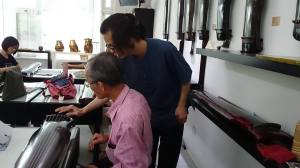20 years on since Wang Letian walked the streets, the dreams for ethnic equality have long since been strangled out of its final aspiration; in its place now is a weapon of neo-imperialism and tool of cultural genocide
This post was originally published on medium.com on June 1, 2023.

To much surprise of human rights watchers around the world, Fang Bin was officially released on April 30, 2023 from his 3-year long detention for uncovering the “unknown pneumonia” outbreak as a citizen reporter in early 2020. While he is but only one of many such reporters amateur to professional arrested, one would be amiss to overlook the cross-collar on his simple navy-colored tunic, as Fang is a participant wearer and vendor of hanfu, short for Han ethnic traditional clothing, a fact also widely reported. Misfortune unfurled when he was bounced around by Wuhan police northwards to Beijing in attempt to get rid of him by sending him to his son for shelter, but the Beijing jurisdiction sent him back likewise the very next day to Wuhan by high-speed train. When he returned to his business’ warehouse in Hankou (the northern bank of the Yangtze in Wuhan) to only find that his goods — as well as most records of his presence — were seized and wiped clean off the record since 2020. According to sources close to him and reported by both The Epoch Times and Radio Free Asia on May 2, he is now wandering homeless through the streets and watched by Wuhan police, who stand ready to monitor or even arrest those who may connect or associate with him. While this treatment is shocking and intolerable to any free individual living in a free society, Fang Bin’s deplorable condition is a familiar situation to Chinese human rights watchers, and is to what Chinese law scholar Jerome A. Cohen calls a “Non-release release (NRR),” as a device of the communist regime’s all-encompassing stability maintenance project.
But while the greater public remember Fang Bin as being incarcerated for his role as a citizen reporter, his other identity as a hanfu movement pundit is much less well-known and understood by international attention. Fang is not simply an apparel vendor, but that this occupation was merely a peek into his subscription to Hanism — thereby making him into what people refer to as a “Huang-Han”. Literally translated as Great Han, it refers to people who are concerned about the interests of the Han ethnicity, and were the ideological basis that gave birth and rise to the clothing movement that achieved traction starting late 2003. While an increasing youth and general populace rediscovered and flaunted the grace and beauty of flowing robes and fluttering hems as one of the three “spending traps” of late 2010’s modern Chinese female fashion on social media along with JK (joushi-kousei, Japanese high school girl) uniform styles and lolita fashion, the dark underside is that such recognition and acceptance came at the expense of palpable social conflict and sacrificing its original mandate with co-option by the communist regime’s state apparatuses.
Hanism — The ‘broad church’ has burned down

In his 2016 study, James Leibold described the Hanfu Movement of the early 2010’s as ‘a broad church’, with its “supporters using the category of Han to explicitly question the Chinese Communist Party’s (CCP) multi-ethnic mosaic while others are more interested in cosplay and the revival of traditional Han culture.” While he later wrote about his experiences interacting with members of Hanwang in the early 2010s and describing it as a Chinese take on Stormfront (the white supremacist internet forum) rife with xenophobia and death-threats, what he witnessed was but one of many splintered versions of Hanwang, some of which have long since changed their names, gone into obscurity, or worse — into total lockdown and censorship, since the Uyghur-Han ethnic troubles of June and July 2009. While the Uyghur’s systematic persecution and cultural genocide, along with the revocation of the One Child Policy under the Xi Jinping regime sounded like sweet revenge on a cold silver platter resounding music to the stereotypical supremacist agenda, there is no sound of celebration or reflective concern as all discussion online have ceased in the tightening of freedom of expression. Registered owners of the Hanist forums have long since been kept on government surveillance. Whereas the talk of Uyghur oppression and genocide could be easily understood and promoted to the world as familiar racial politics, or how Hong Kong localism, despite its wildly differing expression ranging the full political spectrum from the left to the extreme right, is at least made digestible to 90-second international news by way of presenting an identity easily distinguishable using familiar building blocks of nationalism such as language, geography, and a clear bifurcation of destiny. However, Hanists as a part of the majority ethnicity and social mainstream are much less visible, more so when they are more moderate than the slogan-shouting counterparts online.
In the 2006 essay “Hanfu Movement: a New Citizen movement”, Wang Hongbo, moderator of Baidu Hanfu Bar, wrote under the alias of “Xishan Qinkuang” that:
汉服应“新民”,它本身即是精神独立的产物,它应该重塑一群更加拥有独立精神和自主思考能力的人。
Hanfu should be “New Citizen”, as it itself is a product of spiritual independence. It should foster a group people with more individual spirit and independent thinking.
汉服应“新民”,它应该塑造一群拥有世界级文化大国气度和自信的国民。
Hanfu should be “New Citizen”, as it should be designed to cultivate a citizenry embodying the magnificence and self-assurance of a great cultural nation on the world stage.
汉服应“新民”,它应该撑起强势崛起的民间力量,实现中国前所未有的民间的文明觉醒。
Hanfu should be “New Citizen”, as it should be the pillar to the meteoric rise of civil power, to actualize the unprecedented awakening of civilization from the people.
Xishan Qinkuang concluded with these points after observing the Chinese public anxiety and lashback to common or shared roots of heritage being recognized on the international stage, such as his contemporary issue with the UNESCO recognition of Dano (Duanwu) festivities unique to Gangneung City, Gangwon-do, South Korea. Such public anxiety-led hostilities continue to prevail today, such as the recent issue over the Mamianqun and the design house Dior’s 2022 clothing line.
One of the original goals of the hanfu movement was to have it be recognized and promoted by the People’s Republic government, as some pundits believed that pursuing for official recognition as the Chinese national dress (and later conceded to official ethnic dress) would be a significant step forward. As many of these supporters aged and found their way into various government and Party apparatuses, the whole process has turned into a sort of Faustian curse. As I have detailed at length in my 2018 article about the Chinese Communist Party’s appropriation of hanfu into “Huafu” was by design to let the Communist Youth League hijack the original movement and assimilate the hanfu movement’s success into the Chinese state-backed cultural industry, reforging the call for Han distinctiveness into a schizophrenic representation, at times identifying itself as “one of the 56, a part of the Zhonghua Minzu” while at other times a symbol of China’s imperial glory — whether to demonstrate its exertion of influence abroad, or to weaponize it as a replacement agent to Sinoxenic ethnic expressions, especially those related to the Muslim minorities.

Discourse and power: co-option and resistance
Fang Bin fits the classic definition of a liberal, civic-minded Hanist, as he took his phone camera to the streets and hospitals out of concern to the welfare of his people, and calling out online to warn the public of the Wuhan unknown pneumonia outbreak and to the government for civic autonomy along with government transparency. Protest and demonstration not only dot and intersperse throughout the history of the hanfu movement, they are the crux and turning points that contribute to its success in instilling social change.

In 2006, several citizens accused a Beijing digital company of libel by spreading an altered report on a photo article by Jinghua Shibao which originally read “Hanfu Gathering” in the title to “Joss Clothing Takes to the Streets.” On October 5 2008, after numerous verbal confrontations from various occasions, 30-year old hanfu activist and amateur historian Huang Haiqing slapped 74-year old Manchu history scholar Yan Chongnian in the face during a book-signing session, denouncing Yan for whitewashing Manchu conquest and genocide of Chinese people with the term “a case of ‘cultural fusion’,” resulting in Huang receiving maximum sentence of a 1,000 Yuan fine and 15 days in detention.

Hanfu was also bore the brunt and bane of “Chinese nationalists” during this time, most notably during the Chongyang Day Chengdu hanfu burning incident on October 16, 2010, when anti-Japanese protesters marching in downtown Chengdu spotted Sun Ting (alias) through the window of a fried chicken restaurant, pulled her out and demanded that she surrender her quju robes or face further violence. Sun relented, taking off both her outer and inner layer dress, and had to hide in the washroom until someone donated a pair of jeans for her to leave. Protesters then set fire to her “Japanese” clothes under the watch of dozens video and photo cameras. [Yeung, 2010] One year later, the resolution was for the victims themselves to lick their wounds and remain vigilant, but otherwise no public justice rendered aid. [ibid, 2011]
Then on March 19, 2012, Hu Shen, then a Gr.12 student, was sent home from school for wearing “strange and unusual clothing” and was almost silenced when the local newspaper attempted to cover the local curiosity, to which when she blew the whistle on the school’s doing on despite being on its “no uniform day”, blew up into national headlines. This was the time when public opinion started to shift as notable public figures started speaking in defense of Hu, despite the non-recognized status of hanfu as the image of the Han by the state. [Yeung, 2012]

These kinds of news started to wane with the rise of Xi Jinping as General Secretary of the CCP and national leader in 2013. While the process was gradual, official rhetoric seemingly started to accept hanfu — but rather as an act of recognizing Han heritage and thereby its equal status with the other ethnic minorities as having something culturally distinct from them, it was the ‘common denominator’ that binds the minorities together across this “Zhonghua”, central land. Instead of celebrating the Confucian cultural sphere heritage of Han ethnic dress with its neighbouring countries of Mongolia, Vietnam, Korea and Japan as an icon of commonality and amicability, now it is toted as a casus belli to lay stake and claim to patent sovereignty in a sort of cultural “scramble for Africa”, where the indigenous are often co-opted as ‘wolf warriors’ for the neo-colonial state — fierce, tribal, mercenary. Those who resist joining its ranks are silenced and put under internet and in-person watch, unable to speak publicly except in hushed private communiques over VPNs to those in the know overseas. Fang Bin is just the latest example of a long line of Hanists who tried to speak truth in rescuing the nation from its whitewashing history as it happens, as was Huang Haiqing and the numerous owners of the former versions of Hanwang forums.
Outside the wall — What we are to do
It is important to remember that the purpose of restoring Han dress is predicated on the original visions and values of Chinese modernity itself as a nation — to shed itself from the imperialistic, colonialist mindsets and join the world as equal members on the global stage. Breaking past the negative feedback loop between self-victimizing and returning to become the aggressor is not only a lesson for this movement, but for the fate of all peoples involved.
There are already groups of people whom have the perspective and means to start achieving this in action and act as the role models for this better future already — those in the diaspora. We must not forget the local impetus and conditions, as well as the global connections for why and how this movement lifted off in China.
By wearing hanfu, we remember the genocide of Manchu conquest and Queue Order that took it out of existence for 300 years. By wearing hanfu, we remember how revolutionaries tried during all this time to restore the dress, but time and again was sabotaged by the political zeitgeist of the time — the Taipings and the struggle between restoring Ming versus forming a new (Christian?) society, the Hanist 1911 revolutionaries irked by Yuan Shikai (a former Qing general) donning the dress and then subsequently attempt to restore monarchism, and now the contemporary movement facing the strong backlash of these memories plus the prospect of history repeating itself with Xi Jinping — and learn to never repeat the mistakes of the past. By wearing hanfu, we put on the confidence and pride of our ethnic heritage and become aware that others have a history and challenges just like our own, and let it become a daily warning seeking for truth and reminder striving for reconciliation.
As we pick up confidence to recreate hanfu from its traditional patterns, , innovate new designs abiding by its design principles, and share the clothes to others by gifts and the fashion market, we are also sharing the ongoing hardships of getting over the post-colonial experience, and open our hearts to learn other peoples’ legacies, empathizing with their plight, and standing in solidarity in the face of oppression.
Whether the hard work of the past 20 years of this movement succeeds or fails now rests upon our decision — will we let it yet again become an embarrassing symbol of resurgent imperialism like the dirndl and lederhosen of German Volkstrachten, taking at least another generation or two possibly to shake off the association, or will we willingly take hold of the discourse and provide the alternative before the damage is done?
Juni L. Yeung, MA (Toronto) is a cultural historian, tailor of hanfu, and the co-founder of the Hanfu Movement of Eastern Canada. She has been observing and involved with the Hanfu Movement since its inception in late 2003 on Hanwang, and was also the co-founder of the Toronto Association for the Restoration of Hanfu, the first hanfu promotion association outside of China.















Recent Comments